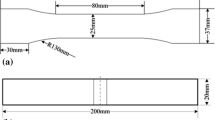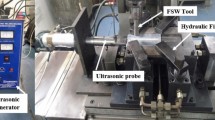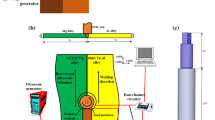Abstract
Ti6Al4V and 6061-T6 Al alloys were joined by ultrasonic-assisted friction stir welding (UAFSW) at different rotational velocities and pin offsets to explore the influencing mechanisms of the ultrasonic. Results indicate that the positive or negative influence of ultrasonic depends on the welding condition. Applying ultrasonic increases the joint tensile strength at 450 rpm ~ 850 rpm rotational velocity and 1.2 mm pin offset because it does not only decreases the void defect and the size of Ti6Al4V fragments but also promotes the diffusion bonding at Al/Ti interface. When a large pin offset of 1.6 mm is used, a thick intermetallic compounds (IMCs) layer is formed at the Al/Ti interface and large Ti6Al4V fragments appear in the stir zone. Applying ultrasonic at the large pin offset induces cracks initiating in the thick IMCs layer and the formation of large void defect in the stir zone. This investigation provides a reference for the reasonable application of UAFSW technique.








Similar content being viewed by others
Data Availability
All data are included in the manuscript.
References
Ma Z, Wang Y, Ji S, Xiong L (2018) Fatigue properties of Ti-6Al-4V alloy friction stir welding joint obtained under rapid cooling condition. J Manuf Process 36:238–247
Choi JW, Liu H, Fujii H (2018) Dissimilar friction stir welding of pure Ti and pure Al. Mater Sci Eng A 730:168–176
Nikulina AA, Smirnov AI, Turichin GA, Klimova-Korsmik OG, Babkin KD (2017) Special features of the structure of laser-welded joints of dissimilar alloys based on titanium and aluminum. Met Sci Heat Treat 59:534–539
Wang T, Li X, Zhang Y, Li H, Zhang B, Feng J (2017) Regulating the interfacial morphology of electron beam welded pure Ti/2024Al dissimilar joint. J Mater Process Technol 245:227–231
Ma Z, Wang C, Yu H, Yan J, Shen H (2013) The microstructure and mechanical properties of fluxless gas tungsten arc welding-brazing joints made between titanium and aluminum alloys. Mater Des 45:72–79
Wei S, Li Y, Wang J, Liu K, Zhang P (2014) Microstructure and joining mechanism of Ti/Al dissimilar joint by pulsed gas metal arc welding. Int J Adv Manuf Technol 70:1137–1142
Chen S, Li L, Chen Y, Huang J (2011) Joining mechanism of Ti/Al dissimilar alloys during laser welding-brazing process. J Alloys Compd 509:891–898
Song Z, Nakata K, Wu A, Liao J (2013) Interfacial microstructure and mechanical property of Ti6Al4V/A6061 dissimilar joint by direct laser brazing without filler metal and groove. Mater Sci Eng A 560:111–120
Lv SX, Jing XJ, Huang YX, Xu YQ, Zheng CQ, Yang SQ (2012) Investigation on TIG arc welding–brazing of Ti/Al dissimilar alloys with Al based fillers. Sci Technol Weld Join 17:519–524
Ma Z, Li Q, Ma L, He Z, Liang Z (2019) Fatigue behavior of MiG-welded 7N01-T4 aluminum alloy with different V-groove angles. Arch Metall Mater 64:1577–1584
Kim Y-C, Fuji A (2002) Factors dominating joint characteristics in Ti–Al friction welds. Sci Technol Weld Join 7:149–154
Rajakumar S, Balasubramanian V (2016) Diffusion bonding of titanium and AA 7075 aluminum alloy dissimilar joints—process modeling and optimization using desirability approach. Int J Adv Manuf Technol 86:1095–1112
Zhang CQ, Robson JD, Ciuca O, Prangnell PB (2014) Microstructural characterization and mechanical properties of high power ultrasonic spot welded aluminum alloy AA6111-TiAl6V4 dissimilar joints. Mater Charact 97:83–91
Meng X, Huang Y, Cao J, Shen J, dos Santos JF (2021) Recent progress on control strategies for inherent issues in friction stir welding. Prog Mater Sci 115:100706
Zhou L, Zhou WL, Feng JC, He WX, Huang YX, Dong SS (2016) Effect of rotation speed on the microstructure and mechanical properties of dissimilar friction stir-welded copper/brass metals. Int J Adv Manuf Technol 84:1335–1343
Xu WF, Wu XK, Ma J, Lu HJ, Luo YX (2019) Abnormal fracture of 7085 high strength aluminum alloy thick plate joint via friction stir welding. J Mater Res Technol 8:6029–6040
Xu WF, Luo YX, Fu MW (2018) Microstructure evolution in the conventional single side and bobbin tool friction stir welding of thick rolled 7085-T7452 aluminum alloy. Mater Charact 138:48–55
He B, Cui L, Wang D-P, Li HJ, Liu CX (2020) Microstructure and mechanical properties of RAFM-316L dissimilar joints by friction stir welding with different butt joining modes. Acta Metall Sin (English Lett) 33:135–146
Ji SD, Wen Q, Li ZW (2020) A novel friction stir diffusion bonding process using convex-vortex pin tools. J Mater Sci Technol 48:23–30
Meng X, Jin Y, Ji S, Yan D (2018) Improving friction stir weldability of Al/Mg alloys via ultrasonically diminishing pin adhesion. J Mater Sci Technol 34:1817–1822
Liu Z, Meng X, Ji S, Li Z, Wang L (2018) Improving tensile properties of Al/Mg joint by smashing intermetallic compounds via ultrasonic-assisted stationary shoulder friction stir welding. J Manuf Process 31:552–559
Abdollahzadeh A, Shokuhfar A, Cabrera JM, Zhilyaev AP, Omidvar H (2018) The effect of changing chemical composition on dissimilar Mg/Al friction stir welded butt joints using zinc interlayer. J Manuf Process 34:18–30
Huang Y, Meng X, Xie Y, Li J, Wan L (2018) Joining of carbon fiber reinforced thermoplastic and metal via friction stir welding with co-controlling shape and performance. Compos Part A Appl Sci Manuf 112:328–336
Huang Y, Meng X, Xie Y, Wan L, Lv Z, Cao J, Feng J (2018) Friction stir welding/processing of polymers and polymer matrix composites. Compos Part A Appl Sci Manuf 105:235–257
Li P, Chen S, Dong H, Ji H, Li Y, Guo X, Yang G, Zhang X, Han X (2020) Interfacial microstructure and mechanical properties of dissimilar aluminum/steel joint fabricated via refilled friction stir spot welding. J Manuf Process 49:385–396
Derazkola HA, Eyvazian A, Simchi A (2020) Submerged friction stir welding of dissimilar joints between an Al-Mg alloy and low carbon steel: thermo-mechanical modeling, microstructural features, and mechanical properties. J Manuf Process 50:68–79
Song Z, Nakata K, Wu A, Liao J, Zhou L (2014) Influence of probe offset distance on interfacial microstructure and mechanical properties of friction stir butt welded joint of Ti6Al4V and A6061 dissimilar alloys. Mater Des 57:269–278
Wu A, Song Z, Nakata K, Liao J, Zhou L (2015) Interface and properties of the friction stir welded joints of titanium alloy Ti6Al4V with aluminum alloy 6061. Mater Des 71:85–92
Bang HS, Bang HS, Song HJ, Joo SM (2013) Joint properties of dissimilar Al6061-T6 aluminum alloy/Ti-6%Al-4%V titanium alloy by gas tungsten arc welding assisted hybrid friction stir welding. Mater Des 51:544–551
Li B, Zhang Z, Shen Y, Hu W, Luo L (2014) Dissimilar friction stir welding of Ti-6Al-4V alloy and aluminum alloy employing a modified butt joint configuration: influences of process variables on the weld interfaces and tensile properties. Mater Des 53:838–848
Zhong YB, Wu CS, Padhy GK (2017) Effect of ultrasonic vibration on welding load, temperature and material flow in friction stir welding. J Mater Process Technol 239:273–283
Lv X, Wu CS, Yang C, Padhy GK (2018) Weld microstructure and mechanical properties in ultrasonic enhanced friction stir welding of Al alloy to Mg alloy. J Mater Process Technol 254:145–157
Ma Z, Jin Y, Ji S, Meng X, Ma L, Li Q (2019) A general strategy for the reliable joining of Al/Ti dissimilar alloys via ultrasonic assisted friction stir welding. J Mater Sci Technol 35:94–99
Guan M, Wang Y, Huang Y, Liu X, Meng X, Xie Y, Li J (2019) Non-weld-thinning friction stir welding. Mater Lett 255:126506
Mehta KP, Carlone P, Astarita A, Scherillo F, Rubino F, Vora P (2019) Conventional and cooling assisted friction stir welding of AA6061 and AZ31B alloys. Mater Sci Eng A 759:252–261
Ji S, Li Z, Zhang L, Wang Y (2017) Eliminating the tearing defect in Ti-6Al-4V alloy joint by back heating assisted friction stir welding. Mater Lett 188:21–24
Liu X, Wu C, Padhy GK (2015) Characterization of plastic deformation and material flow in ultrasonic vibration enhanced friction stir welding. Scr Mater 102:95–98
Thomä M, Wagner G, Straß B, Wolter B, Benfer S, Fürbeth W (2018) Ultrasound enhanced friction stir welding of aluminum and steel: process and properties of EN AW 6061/DC04-Joints. J Mater Sci Technol 34:163–172
Chen Y, Liu H, Feng J (2006) Friction stir welding characteristics of different heat-treated-state 2219 aluminum alloy plates. Mater Sci Eng A 420:21–25
Ji S, Li Z, Wang Y, Ma L (2017) Joint formation and mechanical properties of back heating assisted friction stir welded Ti–6Al–4V alloy. Mater Des 113:37–46
Ji S, Hu W, Ma Z, Li Q, Gong X (2020) Friction stir lap welding of Mg/Ti dissimilar alloys using a slight penetration depth. JOM 72:1589–1596
Huang Y, Lv Z, Wan L, Shen JJ, dos Santos JF (2017) A new method of hybrid friction stir welding assisted by friction surfacing for joining dissimilar Ti/Al alloy. Mater Lett 207:172–175
He P, Yue X, Zhang JH (2008) Hot pressing diffusion bonding of a titanium alloy to a stainless steel with an aluminum alloy interlayer. Mater Sci Eng A 486:171–176
Yao W, Wu A, Zou G, Ren J (2008) Formation process of the bonding joint in Ti/Al diffusion bonding. Mater Sci Eng A 480:456–463
Sato YS, Urata M, Kokawa H, Ikeda K (2003) Hall-Petch relationship in friction stir welds of equal channel angular-pressed aluminium alloys. Mater Sci Eng A 354:298–305
Dong P, Sun D, Li H (2013) Natural aging behaviour of friction stir welded 6005A-T6 aluminium alloy. Mater Sci Eng A 576:29–35
Dong P, Li H, Sun D, Gong W, Liu J (2013) Effects of welding speed on the microstructure and hardness in friction stir welding joints of 6005A-T6 aluminum alloy. Mater Des 45:524–531
Funding
This project was supported by the National Natural Science Foundation of China (Nos. 51705339 and 51874201) and the Program for Liaoning Innovative Talents in University (No. LR2019049).
Author information
Authors and Affiliations
Contributions
Zhongwei Ma: Conceptualization, methodology, and software. Xiao Sun: Data curation and writing-original draft preparation. Shude Ji: Visualization, investigation, writing-reviewing, and editing. Yue Wang: Supervision. Yumei Yue: Software and validation.
Corresponding authors
Ethics declarations
Ethical approval
This study does not involve human participants or animals.
Consent to participate
All the authors listed have approved to participate.
Consent for publication
All the authors listed have been approved to publish in this journal.
Competing interests
The authors declare that they have no competing interests.
Additional information
Publisher’s note
Springer Nature remains neutral with regard to jurisdictional claims in published maps and institutional affiliations.
Rights and permissions
About this article
Cite this article
Ma, Z., Sun, X., Ji, S. et al. Influences of ultrasonic on friction stir welding of Al/Ti dissimilar alloys under different welding conditions. Int J Adv Manuf Technol 112, 2573–2582 (2021). https://doi.org/10.1007/s00170-020-06481-6
Received:
Accepted:
Published:
Issue Date:
DOI: https://doi.org/10.1007/s00170-020-06481-6




